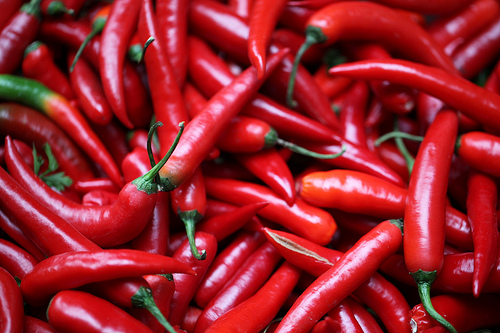Chiles (Capsicum spp.) have been cultivated in Mexico for centuries and are a vital ingredient in Mexico’s traditional cuisine, recently recognized by UNESCO as an “Intangible Cultural Heritage of Humanity.” Spicy chiles also have numerous medicinal uses. Graphical representations of chiles have even been used as a national symbol.
Chiles are native to Mexico and central America. Evidence for chiles in the diet of indigenous groups in Puebla’s Tehuacán Valley dates back at least as far as 6500BC; by 4100BC, the plant was already domesticated.
There are more than 100 varieties of chiles, grouped into 22 groups of green chiles and 12 of dried chiles. Green chiles by far the most important in volume and value of production and trade. Mexico remains the world’s leading exporter of green chiles and is the sixth largest exporter of dried chiles. The world’s leading producer of green chiles, almost entirely for domestic consumption, is China.
The ideal conditions for cultivating chiles are:
- growing season temperatures of 18-27̊C daytime and 15-18̊C during the night.
- rainfall of 600-1250 mm/yr, with no marked dry season.
- light, humus-rich soils with adequate moisture retention and drainage
- soils with a pH between 5.5 (slighty acidic) and 7.0 (neutral)
- growing season of at least 120 days
Crop yields can be adversely affected by:
- plagues,
- plant diseases,
- climatic hazards, such as hailstorms, rainstorms (fields need efficient drainage systems) and frost, the risk of which is countered by burning waste to create smoke to maintain temperatures above freezing
Time frame for cultivation
- on commercial chile farms, seeds are usually sown in enclosed, heated, nursery beds, since temperatures of 20-24̊C are considered ideal for germination
- seedlings are transplanted after 25-35 days when they are about 10-20cm in height – optimum yields require 20,000-25,000 plants per hectare
- the first flowers appear 1-2 months later, by which time the plant is 30-80 cm tall
- the first green chiles ripen about a month after that; chiles can then be picked every week or so for up to 3 months in rain-fed fields, or sometimes over an even longer period in irrigated fields.
In ideal circumstances, harvesting is possible all year. There are two major, overlapping harvest periods each year, with a fall-winter crop from December-August, and a spring-summer crop from June to March.
Yields vary greatly, reflecting different qualities of soil, water supply and technification employed. The average yield across Mexico is 14-15 metric tons/hectare. Yields in Zacatecas (which has a larger cultivated area of chiles than any other state in Mexico) are only 7 tons/ha, while yields in Sinaloa reach as high as 40 tons/ha.
Types of chile grown in Mexico
The most commonly grown chiles in Mexico are jalapeño, serrano, habanero, poblano and morrón (bell pepper). Seven varieties of green chiles represented 90% of Mexico’s total production of chiles in 2008, and 60% of its total revenue from chiles. Chiles vary in color, heat, size and texture:
Even for a single species, the “heat” of its chiles varies from one plant to the next, as well as from one soil or location to another. The heat of chiles is measured in Scoville units. The hottest chile is generally thought to be the habanero (100,000-445,000 Scoville units). By comparison, the jalapeño is 2,500-5,000 units and the morrón chile (bell pepper) registers 0 Scoville units.
- The cultivation of chiles in Mexico (the specifics of commercial chile production in Mexico)
Main source for statistics (pdf file): Un panorama del cultivo del chile, SAGARPA: Servicio de Información Agroalimentaria y Pesquera, June 2010. [accessed January 28, 2011]
Agriculture in Mexico is analyzed in chapter 15 of Geo-Mexico: the geography and dynamics of modern Mexico. Ask your library to buy a copy of this handy reference guide to all aspects of Mexico’s geography today! Better yet, order your own copy…

Sorry, the comment form is closed at this time.